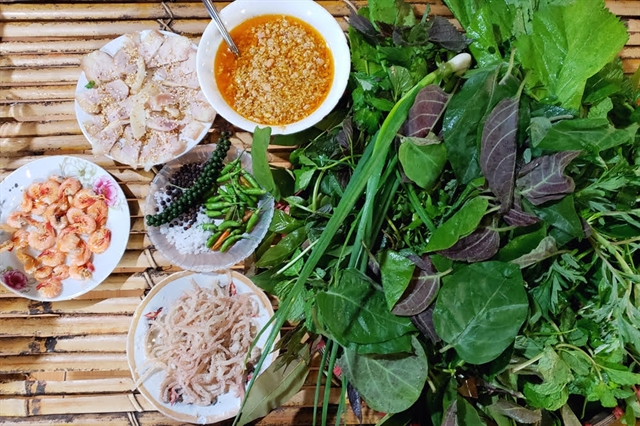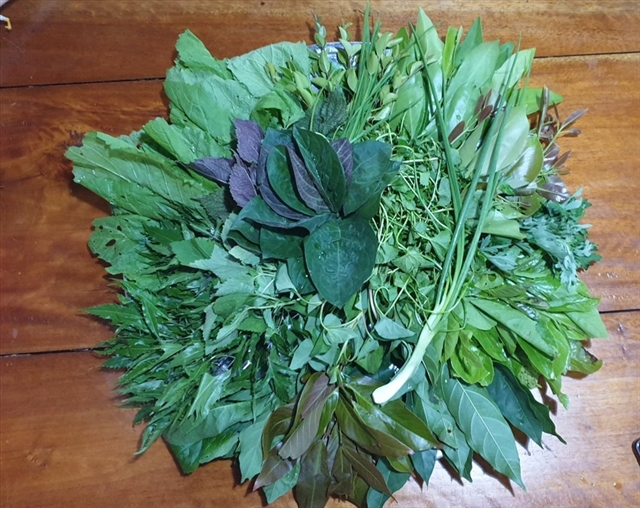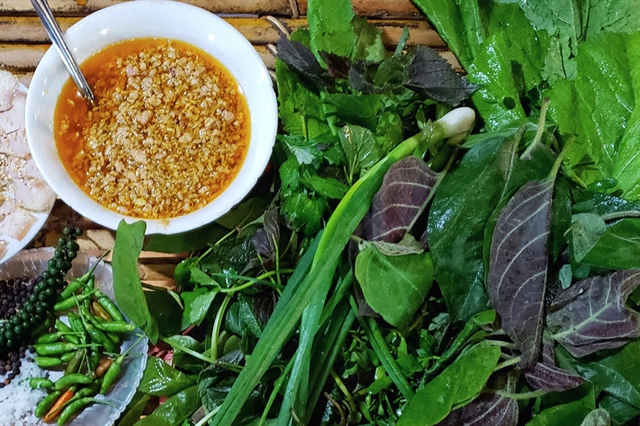Hà Nguyễn and Hoàng Hồ
For veteran Hoàng Minh Bình, gỏi lá (leaf salad) is a speciality of the Central Highlands province of Kon Tum because the dish carries the deep characteristics of the mountain.
Bình recalled that during the American War, he was in a group of five soldiers encircled by the enemy in a Kon Tum jungle for a month.
“We faced hunger for days and though we could have killed wild animals to eat, we were being sought by the enemy troops so none of us dared to make a fire. One of my comrades told us that we should eat wild leaves to survive,” said Bình.
He said first they picked the leaves and tried them one after another because they were afraid of eating a poisonous leaf. The leaves included lá trầm (agarwood) lá ngành ngạnh đỏ (red cratoxylum prunifolium dyer) and others.

A table with fresh wild leave salad to be eaten with bacon, shrimp and boilled pork skin threads. — Photo nhandan.com.vn
“We also dug roots from wild trees such as yam, bub of banana tree, brown tuber and others to eat with the leaves. Luckily one of my friends named Trọng Hải still had a small package of salt so we cut the roots into threads and mixed them with a little salt and wrapped it in the leaves,” said Bình.
Thanks to the wild leaves and roots, Bình’s group escaped from hunger and later found their army unit after a month of being encircled by the enemy troops.
When peace resumed, when Bình returned to Hà Nội he never forgot the wild leaves salad.
Bình was recently invited to join a reunion with soldiers who had fought in Kon Tum.

Fresh leaves picked from the forests help the dish more tasty. — Photo dulich.laodong.vn
“We were so happy to meet each other. All of us agreed to have gỏi lá as our main course at a shop in the Kon Tum Province centre.
"The shop owner named Huỳnh Thị Bảng told us apart from wild leaves which are hard to collect now, she uses other leaves grown in the family garden such as lá ổi (guava), lá xoài (mango), lá sung (fig), càng cua (crab claw herb), tía tô (perilla), lá mơ lông (Rubiaceae) and many others," Bình said.
She said that the leaves were traditionally eaten as salads.
Bình said the dish was tastier because it included bacon and boiled pig’s skin cut into pieces mixed with minced galangal and fried shrimp wrapped with the leaves in rice paper.

A bowl of dipping sauce plays an important role in making the dish unforgettable. — Photo nhandan.com.vn
Other ingredients include unhusked pepper, salt and small green chilli which carries a special fragrance of the Central Highlands’ red basaltic soil in it.
The dish is more enjoyable when using fingers to wrap it, Bảng said, adding that dipping sauce also plays an important role.
The sauce is made from fermented sticky rice, dried shrimp and bacon ground well before being mixed with satay, and spices and then poured into a cooking pan over a small fire for 10 minutes, she said.
Bình said the dish has sweet flavours of bacon, shrimp, hot and fieriness of pepper, chilli and sour and greasy of the sauce in addition to the aromatic and cool flavours of wild leaves.
“I can experience sour, pungent and bitter flavours of each kind of leaf," he said.

Gỏi lá is very suitable for enjoying with a cup of local Măng Đen wine. — Photo vietgiaitri.com
For Bình’s fellow veteran Trọng Hải, the dish in the jungle was unforgettable compared to the modern version with wild and domestic leaves, meat and shrimp.
"Despite this, I still enjoy each sort of leaf to discover more about Kon Tum and the Central Highlands through them,” Hải said.
Local herbalist Y Ngông said eating the leave salad helps improve health because the leaves have rich pharmacological values.
“All of my six family members are healthy because we often eat the leave salad twice or three times a week,” he said, adding that people wishing to try the dish should visit Kon Tum’s Trần Cao Vân Street. — VNS
OVietnam